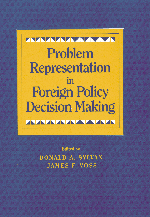Book contents
- Frontmatter
- Contents
- List of Contributors
- Part I Introducing Problem Representation
- Part II Overarching Conceptual Issues
- 3 The Interpretation of Foreign Policy Events: A Cognitive Process Theory
- 4 Problem Identification in Sequential Policy Decision Making: The Re-representation of Problems
- 5 Collective Interpretations: How Problem Representations Aggregate in Foreign Policy Groups
- 6 Image Change and Problem Representation after the Cold War
- Part III Empirical Analysis
- Part IV Conclusion
- Index
6 - Image Change and Problem Representation after the Cold War
from Part II - Overarching Conceptual Issues
Published online by Cambridge University Press: 12 October 2018
- Frontmatter
- Contents
- List of Contributors
- Part I Introducing Problem Representation
- Part II Overarching Conceptual Issues
- 3 The Interpretation of Foreign Policy Events: A Cognitive Process Theory
- 4 Problem Identification in Sequential Policy Decision Making: The Re-representation of Problems
- 5 Collective Interpretations: How Problem Representations Aggregate in Foreign Policy Groups
- 6 Image Change and Problem Representation after the Cold War
- Part III Empirical Analysis
- Part IV Conclusion
- Index
Summary
International political trends after the Cold War have raised many important questions for image theory. First, there are questions concerning image change. The Cold War worldview was composed of some very clear images of international actors. How has that worldview been restructured, if at all? Have new images been formed? Are new tactics associated with emerging images? What has stayed the same in images and policy prescriptions?
Second, were the images in the Cold War worldview only one variation of those particular images? For example, were the enemy and ally images of the Cold War era different from enemy and ally images before and after the Cold War? Were they different from those images in arenas outside of the Cold War conflict during the Cold War? Are there different subtypes of these and other images? Much of image analysis has explored images and resulting policies in the worldview of policy makers deeply involved in the Cold War. Do we now need to look for new images that restructure a changed world and different variations of the images that we knew so well in the Western worldview during the Cold War?
Third, are policy makers who lived through and dealt with the Cold War beginning to recognize, if only implicitly and intuitively, that the nature of conflicts after the Cold War reflects perceptions of opponents that are different in important ways from those they were so familiar with during the Cold War? Has their “problem representation” - that is, the definition, explanation, and interpretation - of the causes of violence and war changed as the conflicts changed?
The first set of questions was theoretically derived and not unanticipated before the end of the Cold War. The second and third sets, however, are a direct result of the kinds of conflicts occurring in the post-Cold War era. Catastrophes like those in Bosnia and Somalia suggest that the enemy image Americans associated with their U.S.-Soviet perceptions was only one type of enemy image. Post-Cold War conflicts also lend credence to the criticism that cognition-based political frameworks treat human beings as computers, and affect must be incorporated into the model (Walker 1988; Jervis 1986, 1989).
- Type
- Chapter
- Information
- Problem Representation in Foreign Policy Decision-Making , pp. 116 - 144Publisher: Cambridge University PressPrint publication year: 1998
- 6
- Cited by



